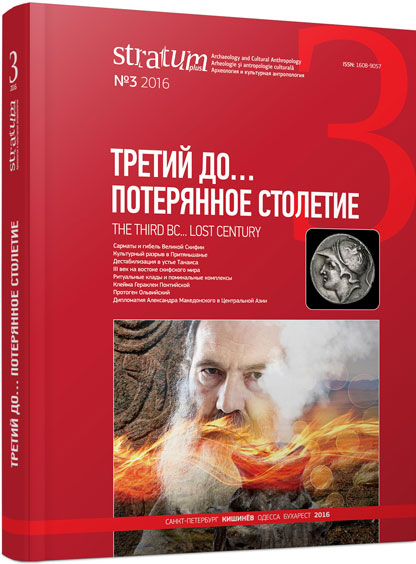«Скипетроносцы» скифской элиты
“The Scepter-bearers” of the Scythian Elite
Author(s): Sergei Aleksandrovich KozlovSubject(s): History, Archaeology, Social history, Ancient World
Published by: Издательский дом Stratum, Университет «Высшая антропологическая школа»
Keywords: North Pontic region; scepter-bearers; classical tradition; Homer; Herodotus; Xenophon; Strabo; Tacitus; Rigveda; Scythians; Sarmatians; Persians; scepters
Summary/Abstract: The present study deals with the “sceptuchi” or “scepter-bearers”, a title of the nobles of Old Iranian peoples (Persians, “Saias”, Sarmatians). The “sceptuchi” led the personal guards of the Achaemenid monarchs, held key government and military posts, including the organization and supervision on the education of the young generation of the nobility. Scepters served as a symbol of their high rank and social status. There is no direct indication about Scythian “scepter-bearers” in ancient texts, but their existence is evidenced by the archaeological and other historical and cultural data. The first part of this paper deals with the question of meaning attributed by the ancient authors (Xenophon, Strabo, Tacitus) to the notions σκηπτοῦχος, sceptuchus etc. and what was the real prototype of their carriers in Pax Iranica, i. e. any real Iranian socio-political and ideological representations of the categories denoted in the ancient texts by these terms. In the second part we try to reconstruct this category for the Scythians and determine the status and functions of the Scythian “scepter-bearers” based on archaeological evidence, circumstantial evidence of ancient texts and comparative historical analogies. The third part addresses the question of what the scepters and other typologically similar attributes of power symbolized in Old Indo-Iranian traditions.
Journal: Stratum plus. Археология и культурная антропология
- Issue Year: 2016
- Issue No: 3
- Page Range: 351-368
- Page Count: 18
- Language: Russian
- Content File-PDF

